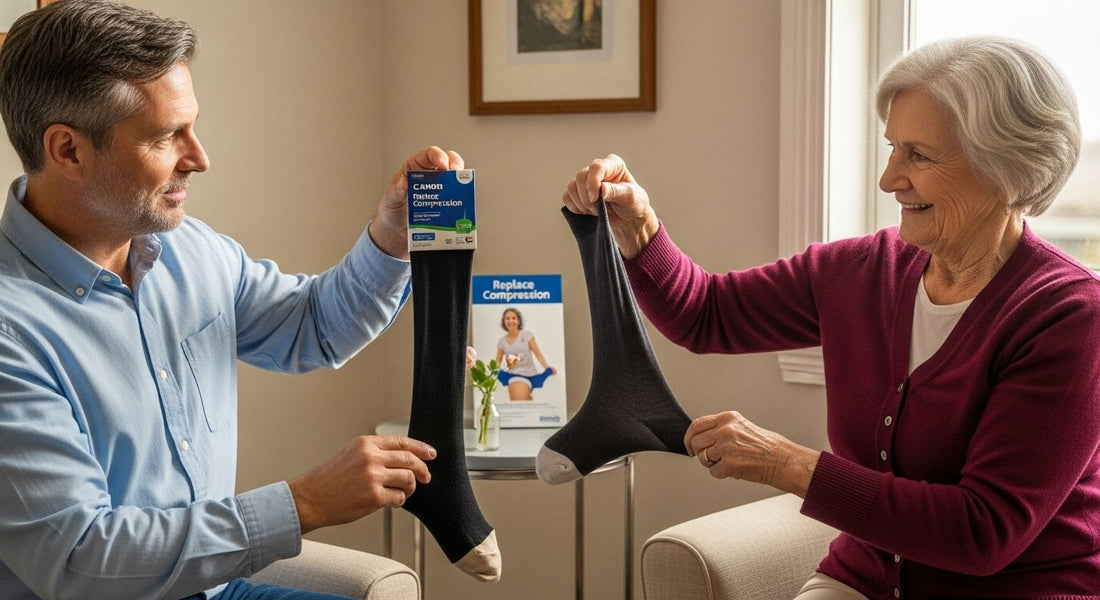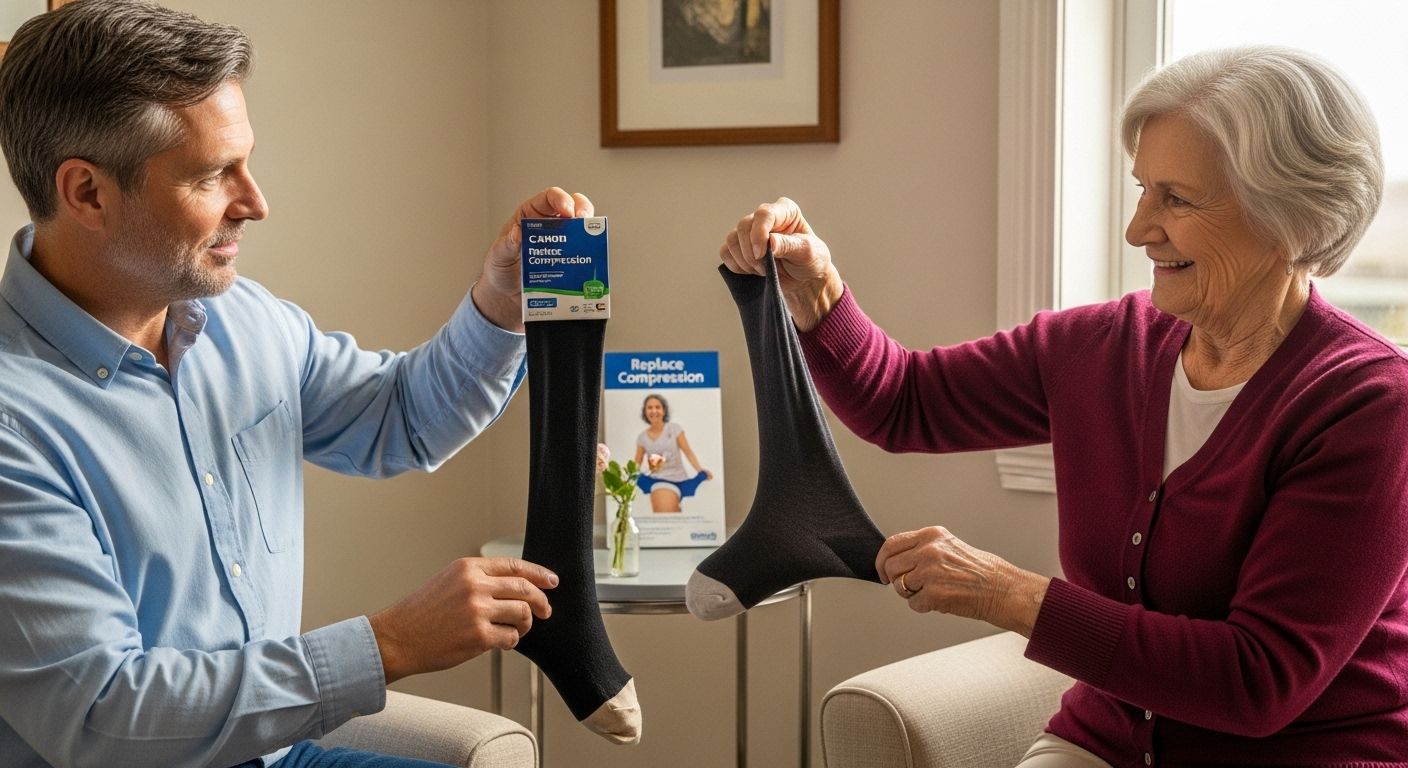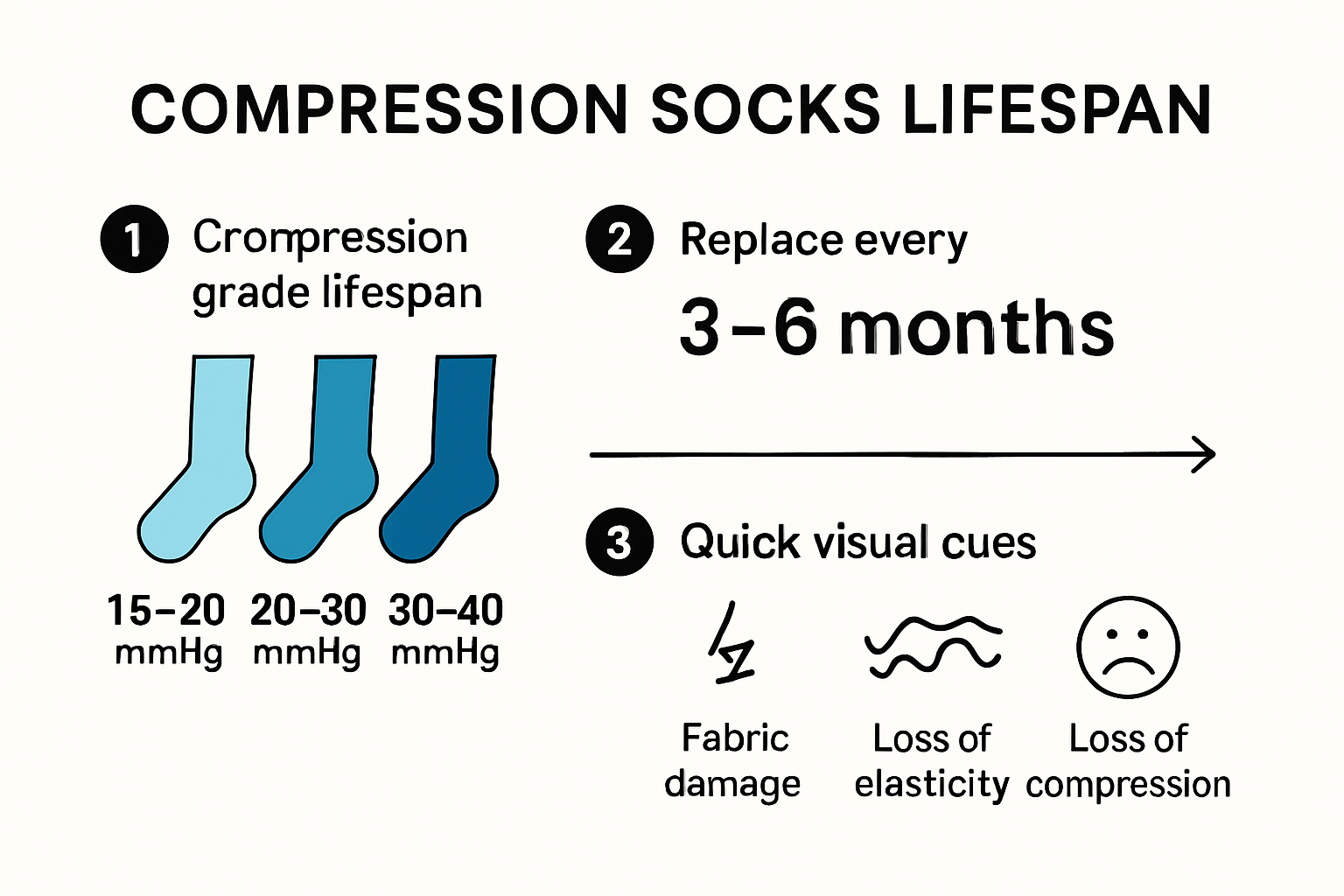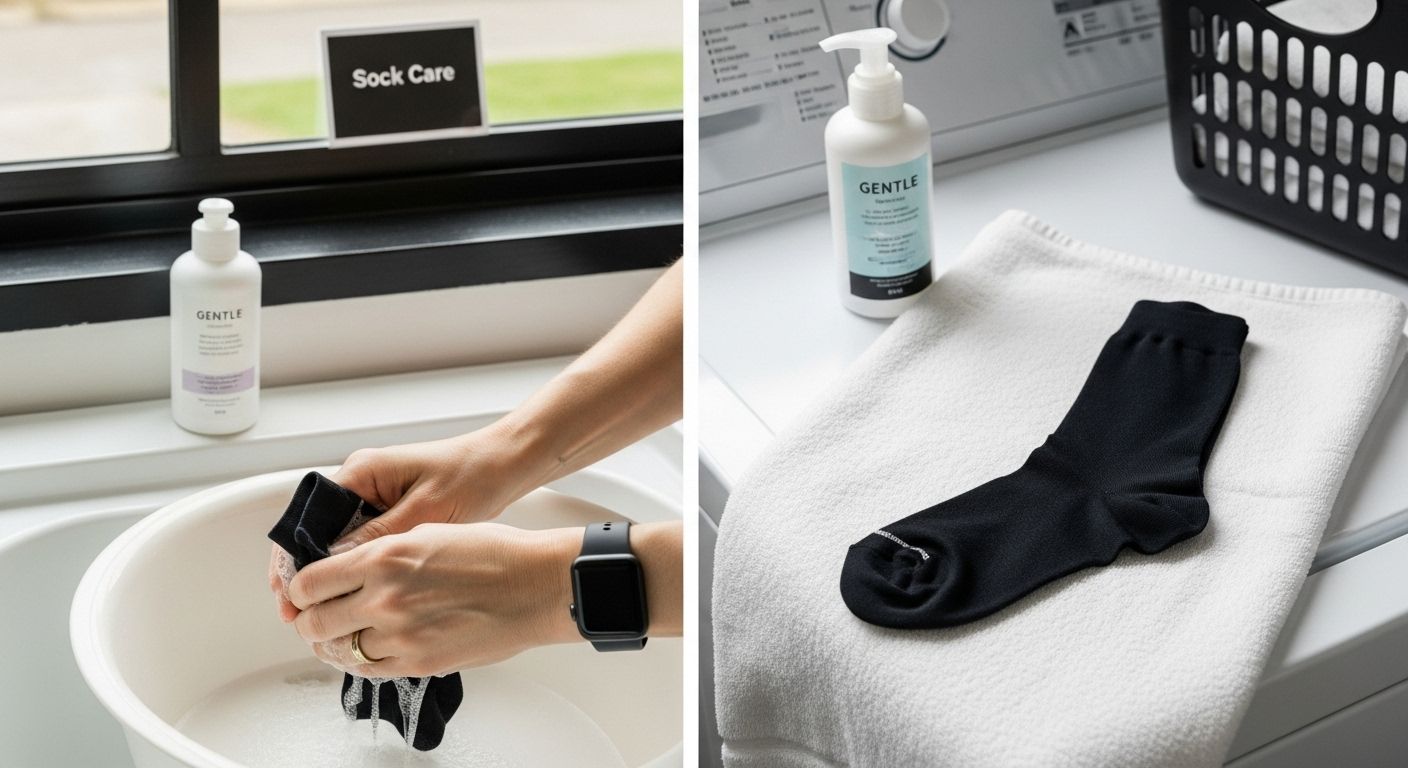
When to Replace Compression Socks: A 2025 Guide for Healthy Legs
Share

Most people think compression socks are good to go as long as they look clean and feel snug. But recent studies show that even the highest quality compression socks start losing effectiveness after just 3 to 6 months. That means relying on worn-out socks can quietly sabotage your leg health long before you see holes or frayed seams.
Table of Contents
- Common Signs Your Compression Socks Need Replacing
- How Long Compression Socks Typically Last
- Replacement Tips For Different Health Needs
- Extending The Life Of Your Compression Socks
Quick Summary
| Takeaway | Explanation |
|---|---|
| Replace socks every 3-6 months | Compression socks lose effectiveness over time; regular replacements ensure optimal leg support and circulation. |
| Inspect for wear and tear frequently | Look for signs of damage like holes or thinning fabric to maintain therapeutic benefits and prevent skin irritation. |
| Proper care extends sock life | Wash with mild detergents and store appropriately to preserve elasticity and longevity of compression socks. |
| Monitor performance and comfort | If socks feel loose or uncomfortable, it’s time for replacements to ensure they continue providing necessary support. |
| Consult healthcare professionals if needed | For specific health conditions, like diabetes or pregnancy, follow tailored replacement guidelines for better health outcomes. |
Common Signs Your Compression Socks Need Replacing
Compression socks are critical medical devices that support circulation and provide therapeutic benefits. Recognizing when these essential garments require replacement is crucial for maintaining their effectiveness and ensuring optimal leg health. Worn or degraded compression socks can significantly reduce their therapeutic impact, potentially compromising your circulatory wellness.
Loss of Elasticity and Compression Strength
The primary indicator that compression socks need replacing is a noticeable reduction in their elastic properties. Our guide on selecting compression stockings highlights that these garments rely on precise tension to deliver medical benefits. According to the Kingston and Richmond NHS Foundation Trust, compression stockings should typically be replaced every 3 to 6 months. When socks lose their original snug fit and fail to provide consistent pressure across your legs, their therapeutic value diminishes dramatically.
Key signs of elasticity loss include:
- Sagging fabric that no longer hugs your leg contours
- Visible stretching or thinning of material
- Reduced feeling of consistent pressure compared to when the socks were new
Visible Wear and Tear
The Cleveland Clinic advises patients to carefully inspect their compression socks for physical damage. Microscopic tears, loose threads, and areas of fabric weakness can compromise the sock’s structural integrity. These imperfections not only reduce compression effectiveness but can also create potential skin irritation points.
Critical signs of wear include:
- Holes or thin patches in the fabric
- Fraying edges or seams
- Discoloration or permanent staining
- Visible stretching that distorts the original sock shape
Performance and Comfort Degradation
Beyond visual indicators, your personal experience provides essential feedback about sock performance. When compression socks no longer feel comfortable or provide the same level of support you initially experienced, it is time to consider replacement. Changes in comfort might manifest as increased leg fatigue, reduced swelling control, or a general sense that the socks are not performing as effectively as they once did.
Pay attention to physical sensations such as:
- Reduced circulation feeling
- Increased leg discomfort during or after wearing
- Less noticeable therapeutic pressure
Regular replacement of compression socks ensures you maintain optimal circulatory support and prevent potential health complications. By monitoring these key indicators, you can proactively manage your leg health and ensure continuous, effective compression therapy.
How Long Compression Socks Typically Last

Compression socks are a vital investment in your circulatory health, designed to provide consistent therapeutic support. Understanding their typical lifespan helps you maintain optimal performance and ensure continuous leg wellness. Learn more about selecting the right compression gear to maximize their effectiveness and longevity.
Manufacturer Recommended Lifespan
Research published in Phlebology indicates that most compression socks are engineered to maintain their therapeutic properties for approximately 3 to 6 months of regular use. This timeframe represents the period during which the garment can consistently deliver the prescribed compression level. Factors like material quality, frequency of wear, and maintenance practices significantly influence how long your compression socks will remain effective.
Key factors affecting compression sock lifespan include:
- Frequency of use determines wear and tear
- Washing and care techniques
- Quality of initial manufacturing
- Specific medical grade and material composition
Daily Wear and Performance Degradation
Harvard Health recommends wearing compression socks during daytime activities while removing them at night. This practice helps preserve the sock’s elastic properties and prevents premature breakdown. The constant stretching, body heat, and daily movements gradually reduce the sock’s ability to provide consistent pressure. Professional medical guidelines suggest that even high quality compression socks experience measurable performance reduction after 4 to 6 months of regular use.
Significant performance indicators include:
- Decreased elastic tension
- Reduced ability to maintain prescribed compression levels
- Visible fabric thinning or stretching
Material and Compression Grade Considerations
The durability of compression socks varies depending on their specific medical grade and material composition. Lower grade compression socks (15-20 mmHg) might have a shorter functional lifespan compared to medical grade options (20-30 mmHg or 30-40 mmHg). Premium materials like specialized nylon blends and reinforced elastic fibers can extend the sock’s effective use period.
Typical lifespan ranges by compression grade:
- Mild compression (15-20 mmHg): 3-4 months
- Moderate compression (20-30 mmHg): 4-6 months
- High compression (30-40 mmHg): 5-7 months
Proper care and careful monitoring can help you maximize the functional duration of your compression socks. Regular inspection, gentle washing, and understanding performance indicators ensure you replace these essential garments at the right time, maintaining continuous therapeutic support for your legs.
Here is a table summarizing the typical lifespan of compression socks based on compression strength, as well as recommended replacement intervals for common health needs:
| Compression Grade / Condition | Typical Lifespan / Replacement Interval |
|---|---|
| Mild Compression (15-20 mmHg) | 3-4 months |
| Moderate Compression (20-30 mmHg) | 4-6 months |
| High Compression (30-40 mmHg) | 5-7 months |
| Varicose Veins/Venous Insufficiency | Replace every 4-6 months |
| Diabetes/Circulatory Complications | Inspect weekly, replace at first sign of wear |
| Pregnancy/Lymphedema | Replace every 3-4 months |
Replacement Tips For Different Health Needs
Compression socks serve diverse medical purposes, and understanding how to manage replacements for specific health conditions is crucial. Explore our comprehensive fitting guide to ensure optimal support for your unique health requirements.
Varicose Veins and Venous Insufficiency
Research from the National Institutes of Health indicates that patients with varicose veins and venous insufficiency require more frequent compression sock monitoring. These conditions demand precise compression levels to manage symptoms effectively. Medical professionals recommend replacing compression socks every 4 to 6 months to maintain consistent therapeutic pressure.
Special considerations for varicose vein patients include:
- Monitoring sock elasticity more frequently
- Checking for any changes in leg swelling or discomfort
- Ensuring consistent compression performance
Diabetes and Circulatory Complications
The Cleveland Clinic emphasizes the critical importance of proper compression garment management for diabetic patients. Individuals with diabetes often experience reduced sensation and compromised circulation, making regular sock replacement essential. Diabetic patients should inspect their compression socks more frequently, looking for signs of wear that could potentially cause skin irritation or compromise circulatory support.
Key replacement guidelines for diabetic patients:
- Inspect socks weekly for potential damage
- Replace socks at the first sign of thinning or stretching
- Consult healthcare providers about specific replacement intervals
Pregnancy and Lymphedema Management
Advanced medical research suggests that specialized health conditions like pregnancy and lymphedema require more nuanced compression sock management. Pregnant women and lymphedema patients experience rapid body changes that can affect sock fit and effectiveness. These groups should consider replacing compression socks more frequently to accommodate physical transformations and maintain optimal therapeutic support.
Specific replacement recommendations include:
- Track body changes that might affect sock fit
- Replace socks every 3 to 4 months during pregnancy
- Consider professional measurements at each replacement stage
By tailoring your compression sock replacement strategy to your specific health needs, you can ensure continuous, effective support. Regular assessment, professional consultation, and proactive replacement are key to maintaining optimal circulatory health across different medical conditions. Always prioritize comfort, proper fit, and therapeutic effectiveness when managing your compression sock lifecycle.
Here is a checklist-style table to help you monitor when replacement is needed based on common signs of wear and personal circumstances:
| Sign or Situation | Check Frequency / Action | Replace if: |
|---|---|---|
| Sagging fabric / reduced elasticity | Upon each use | Socks no longer snug |
| Holes, fraying, or thinning fabric | Upon each use | Any visible wear or holes |
| Discoloration / permanent stains | Upon washing/inspection | Stains cannot be removed |
| Socks feel less supportive / loose | Ongoing comfort monitoring | Comfort or support is reduced |
| Changes in swelling or leg discomfort | Weekly (especially with health conditions) | Increased or new symptoms |
| Pregnancy or rapidly changing leg size | At each trimester or as body changes | Socks become tight or loose |
| Diabetic condition / reduced sensation | Weekly | Any fabric defect or discomfort |
Extending the Life of Your Compression Socks
Compression socks represent a significant investment in your health, and proper care can help maximize their effectiveness and longevity. Learn our expert tips for compression sock maintenance to ensure you get the most out of every pair.
Proper Washing and Cleaning Techniques
InformedHealth.org recommends meticulous care to preserve compression sock quality. Washing after each use is crucial, but the method matters significantly. Hand washing with mild detergent or specialized cleaning solutions helps maintain the fabric’s elastic properties and structural integrity. Avoid harsh chemicals, bleach, or fabric softeners that can break down the specialized fibers.
Optimal washing practices include:
- Use lukewarm water (never hot)
- Gentle hand washing
- Mild, specialized detergents
- Air drying away from direct heat or sunlight
Storage and Handling Recommendations
Research published in the journal Vasa emphasizes the importance of proper storage and handling to extend compression sock lifespan. Improper storage can cause premature elasticity loss and fabric degradation. When not in use, store compression socks flat or rolled loosely, avoiding tight folding that can create permanent creases or stretch the material.
Key storage guidelines:
- Store in a cool, dry place
- Avoid direct sunlight exposure
- Keep away from heat sources
- Use breathable storage bags
- Prevent contact with sharp objects
Daily Use and Wear Strategies

Maximizing compression sock longevity requires strategic daily management. Rotate between multiple pairs to reduce individual sock wear and allow adequate recovery time between uses. Put on socks carefully, using appropriate donning techniques that prevent unnecessary stretching. Consider using donning gloves or aids to minimize direct stress on the fabric.
Strategies for minimizing wear and tear:
- Rotate between multiple pairs
- Use careful donning techniques
- Avoid pulling or stretching excessively
- Remove socks carefully
- Inspect for signs of wear after each use
By implementing these comprehensive care strategies, you can significantly extend the functional life of your compression socks. Regular maintenance, careful handling, and proactive monitoring ensure you receive consistent therapeutic benefits while maximizing your investment. Remember that even with perfect care, compression socks will eventually lose their effectiveness and require replacement to maintain optimal leg health and circulatory support.
Frequently Asked Questions
How often should I replace my compression socks?
Compression socks should typically be replaced every 3 to 6 months, as their elasticity and compression strength degrade over time, impacting their therapeutic effectiveness.
What are the signs that my compression socks need replacing?
Key signs include loss of elasticity, visible wear and tear (such as holes or thinning fabric), and a noticeable decrease in comfort or performance while wearing them.
Can I extend the life of my compression socks?
Yes, proper washing with mild detergent, storing them flat or loosely rolled, and rotating between pairs can extend the lifespan of your compression socks.
How do I properly wash and care for my compression socks?
Wash your compression socks by hand in lukewarm water with mild detergent. Avoid harsh chemicals and air dry them away from direct heat or sunlight to maintain their elasticity.
Upgrade Your Leg Health With Trusted Compression Solutions
Reading about when to replace your compression socks highlights how important ongoing support and the right fit are for lasting relief. Comfort and therapeutic results can slip away quietly when socks lose their elasticity or show signs of wear. The article points out that waiting too long can put your circulation at risk, especially if you are managing conditions like varicose veins, lymphedema, diabetes, or pregnancy-related swelling.
Now is the ideal time to renew your compression therapy routine. At Fit Stockings, you can explore a wide range of medical-grade compression stockings in every style and strength, including Jobst and targeted options like 30-40 mmHg for advanced needs. Shop today and benefit from our expert sizing guidance, fast free shipping, and peace of mind returns. Take the next step toward healthier legs and choose compression care you can trust.
Recommended
- How to Choose Compression Socks: A Helpful Guide for 2025 – Fit Stockings
- Compression Stockings and Diabetes: What to Know in 2025 – Fit Stockings
- Compression Stockings for Elderly: 2025 Guide to Healthier Legs – Fit Stockings
- Compression Stockings Fitting Guide 2025: Find the Perfect Fit – Fit Stockings

